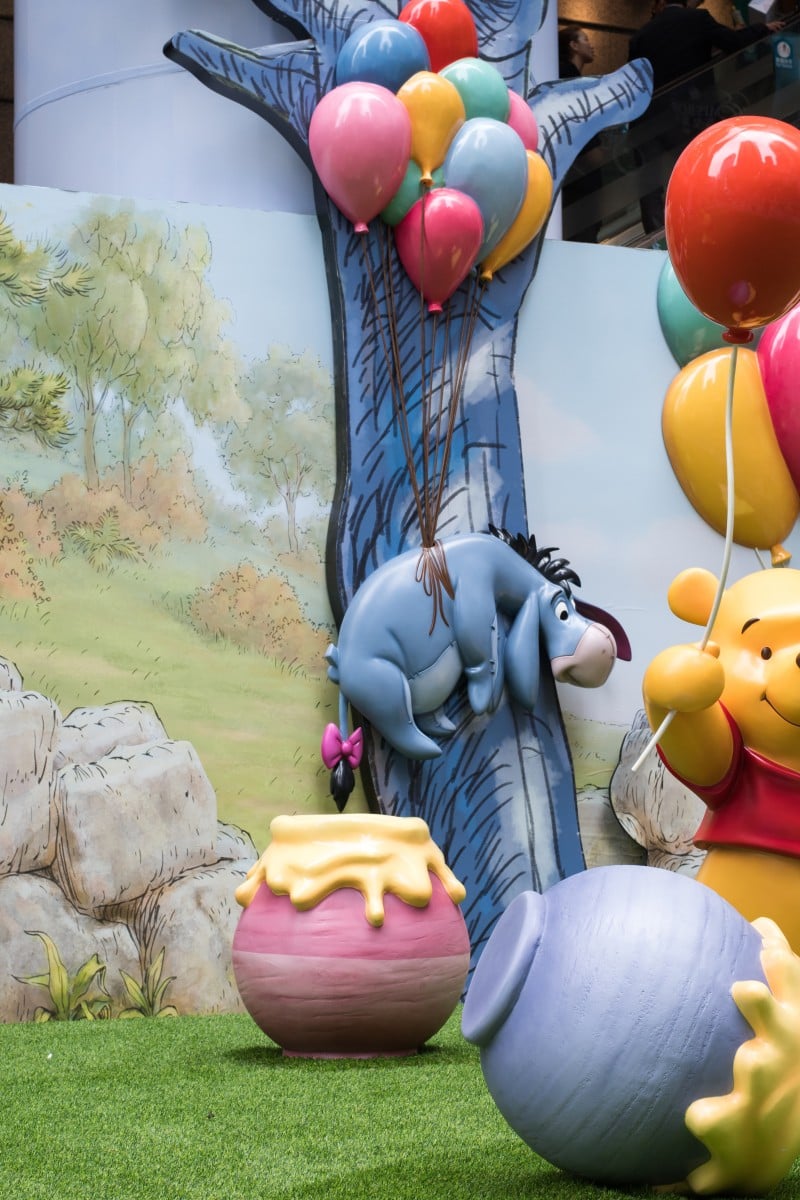
Hong Kong exhibition reveals more than just the bear necessities about Winnie the Pooh from the Walt Disney Archive
An exhibition of items from the Walt Disney Archive shows how Pooh and other animated characters have changed over the years
 The exhibition shows how Winnie the Pooh and other animated characters have changed over the years.
The exhibition shows how Winnie the Pooh and other animated characters have changed over the years.Many children in Hong Kong are raised to be Disney kids: going to Disneyland every holiday and rushing to every Disney movie that comes out. Founded in 1923, the Walt Disney Company is reworking its past all the time, and a team at the Walt Disney Archive are making sure all the stories from the past are told to the generations to come.
The archive is in Burbank, California, and a small portion of it has been flown to Hong Kong with some of its “professional hoarders” – including Rebecca Cline, director and Nicholas V. Vega, manager of collections and exhibits.
On display at Times Square’s Living Room Museum, 92 rare artefacts including sketches, original animated art and soft toys take you into Hundred Acre Wood, where Winnie the Pooh and his friends live happily ever after.
These items have come a long way – 18 hours door to door. Some of the items at the archive are very fragile so they have to choose very carefully which items can stand up to travel. After they are carefully framed and treated, these art pieces travel with professional handlers.
Dehumidifiers aren’t rare in Hong Kong, but at the Living Room Museum, there is one under every group of items, all set to the same level.
The light is also more subdued than normal indoor lighting. “We don’t want the light to damage the art pieces,” says Vega.
Even with these precautions, he is still concerned that extended display periods could damage them. “We take different museum-level measures, including making sure the plastic frames have UV-protected filters,” he adds.
Winnie the Pooh and the Honey Tree was first screened in 1966, but it wasn’t the first time the Walt Disney company introduced Winnie the Pooh to the world. Two years earlier, they authorised a set of merchandise – including soft toys of the main characters.
Have a look and you will instantly notice that many of them look different from the way we know them. Tigger has seen the most obvious change – he walked on all fours, like a normal tiger, while we know him as bouncing on his tail. Piglet used to wear a full suit and Pooh didn’t look as round as he does today. “It’s safe to say, the way Pooh and everyone looks today, I don’t think it’s going to change any time soon,” says Vega.
Cline explains that in the early days, merchandise licensees had more liberty to design the characters differently but now “we are very careful to make them look the same throughout the world”.
However Pooh’s looks have changed, he has been one of the most popular bears for generations thanks to a simple story about love and friendship that was meant for small children.
“It teaches us how to be brave, how to stay happy… things that we all feel and all need,” says Cline.
She adds that everyone has problems in their lives, “but if you just focus on doing what’s right, you can usually get through the problem. I think what’s so important today is to remember those very basic morals and simple solutions to life problems, even if it’s just trying to find honey.”
When asked which character she would spend a day with, Cline laughs and picks the bear. “Eeyore would depress me too much and Tigger would probably get on my nerves.”
Having spent 27 years at the archive, Cline knows how to save things for the future. “We try to collect all the materials that will be important when telling Disney stories in the future, so we have to predict what people are going to ask for 20 years from now,” she says.
It’s easier to collect things from new productions. “Today, when a movie like Beauty and the Beast wraps up, they call us and ask what we want... we need to think ahead about what we need, from scripts to costumes and props; what we’ve been asking for over the past 50 years and what people are going ask for in the next 50 years.”
She feels lucky that the company has held onto a lot of materials from the past, but it wasn’t always the case.
To look for items that are out there, Cline and her team go to auctions, and work with authors and historians who call the archive if they know something is going on the market. They even check eBay regularly.
“But we don’t buy as many things as you might think,” says Cline. Many of their items were donated to the archive; they received calls from families of animators and other former employees who were looking for the right place to donate their working files and collections.
“Sometimes things come to us that we didn’t even know existed any more,” Cline says. One of their recent finds came from a phone call from an animator’s grandson, who had a beautiful painting from the early 1950s – a concept art piece of Peter Pan standing on the deck of a ship, wearing Captain Hook’s hat and costume.
“He gave us a high resolution copy. Sometimes just a copy of something is enough, because what we’re looking for is the history, not so much owning the art or the piece. We just want the historical information,” says the director.
The Walt Disney Archive is not open to the general public, but it’s been a rock for many researchers.
When reimagining movies like Cinderella, Maleficent and Beauty and the Beast, the filmmakers have been to the archive. They have asked to see what the original animators looked at, and read the story notes from the earliest stages. “They can read Walt [Disney]’s notes and see what he was thinking when he was making Pinocchio, for instance,” says Cline.
She uses Saving Mr Banks, which is about the making of Mary Poppins, as an example: “We have all the recordings of the work sessions (on Mary Poppins)… we looked through the scripts and found what was historically right and wrong, and we were consultants on that film.”
Cline still remembers what a thrill it was when she first started working for the archive as a junior secretary.
“I admired Walt Disney so much, it’s very exciting to handle items he dealt with, including the contract that started the company,” she says. “In 1923 Walt signed it and that allowed him to distribute his very first cartoon. After 27 years you can get used to anything, but I still appreciate so much of it.”
Once in a while, she will look up from her desk and see something that brings back memories from her childhood as a Disney kid.
The Winnie the Pooh: Be My Friend exhibition runs until April 23.
